The content of the article
Dracene is called the tree of happiness. The plant has a long trunk and spreading crown, which resembles the top of a palm tree. Flowers unpretentious, tolerate low temperatures normally, but do not like heat. To dracaena always remained green and fluffy, it needs to be watered, fed and regularly transplanted into a new pot. Experienced gardeners know how to move the plant to another pot and do not damage, and are happy to share secrets with amateurs.
Right time
The flower, brought from the store, is kept in a warm room for 4–5 days, but it is protected from direct sunlight and is not watered. During this time, the dracaena will adapt to new conditions and get stronger. Transplant the plant for 6–7 days so that it quickly settles down and does not get sick.
The root system of a young flower is constantly growing,therefore, he is annually bought a pot, the diameter of which is 5–7 cm larger than the old one. Transplantation is carried out in March or April, when it becomes warmer. In the spring of dracaena awakens from winter sleep, the circulation of sap over the stem and roots is accelerated. Due to this green pet is well accustomed, and its growth is accelerating.
Old flowers, which are more than 3-4 years old, are less frequently transplanted. The plant is moved to a larger pot when its root system begins to crawl out from under the soil layer.
In the autumn dracaena prepares for wintering, accumulating useful substances. It is impossible to disturb her, otherwise the crown will turn yellow, the leaves will wither and fall. The rule does not apply to sprouts purchased from a flower shop. Specialists use soil enriched with mineral additives and growth stimulants. If you leave a flower in such soil for longer than 2 weeks, it will get sick and die.
Pot selection
Dracaena takes root well in containers that resemble plastic cups in shape. Oblong species with a wide top and tapering bottom. What material to choose? Breathable, which lets air through. Suitable:
- plastic;
- unglazed clay;
- ceramics.
Choose pots with drainage holes and a tall tray into which to pour water. In winter, it is very difficult to monitor the level of moisture in the soil, and so that due to the excess liquid in the flowerpot the fungus does not start, the dragon flower is watered not from above, but from below.
There are pots in which pallets are securely attached to the base. They are easier to transfer to another room, but you can buy classic versions with removable stands.
The recipe for the right ground
Dracaena, though similar to a palm tree, is more like a slightly acidic or neutral soil. Preference is given to light soil that passes air and does not trap moisture. Flower shops are advised to pay attention to universal land intended for indoor plants. Owners of cottages and country plots can prepare the perfect foundation on their own.
The composition of the correct soil includes:
- turf ground;
- river sand, coarse;
- humus.
Loose components are mixed in equal proportions. You can add peat, leaf soil or dolomite flour to the soil. To get dracaena enough nutrients, the base is enriched with fertilizers:
- potassium;
- double superphosphate;
- microfertilizers.
You can not use the soil, which contains clay. The additive retains water and causes fungus. The heavy and dense basis is combined with small pebbles or coconut fiber, which perform the function of baking powder and regulate the level of moisture.
Land taken from the garden or garden must be disinfected. There are two ways: cold and hot. In the first case, the container with the blank is placed for 1-2 weeks in the freezer. In the second soil steamed or calcined in the oven. High and very low temperatures kill weed spores, insect eggs and fungus. Disinfection is needed to protect dracaena from diseases and parasites that can destroy a plant in a matter of days.
Sand calcined or poured a steep solution of manganese. Pebbles are carefully washed, doused with boiling water and dried. The processed soil is combined with peat and other additives. Components mix well and insist for 5-7 days. During this time, beneficial bacteria will appear in the soil, which are necessary for the growth of dracaena.
Preparatory stage
The pot is filled with crushed clay shards, fine expanded clay or grated foam. The material protects against the accumulation of excess liquid and absorbs moisture from the pallet. The drainage layer occupies a tenth of the pot.
Above the claydite or pebbles piled nutrient base. You can put a layer of coconut fiber to increase the breathability of the earth. Capacity is filled with soil for a quarter. The ground is slightly tamped.
The dragon tree is no longer watered 5-7 days before transplanting. The soil will have time to dry, and it will be easier to remove from the pot. The flower is removed away from direct sunlight so that it rests a bit and becomes stronger. Fertilize the plant is not necessary. Nutrient mixture contribute to the soil after transplantation. They accelerate the adaptation and growth of the root system.
Extraction and inspection
Dracaena is very fragile. It is easy to damage a flower if you strongly or sharply pull the stem, so it is removed from the pot carefully and slowly.
The pot is turned, knocked on the bottom with your fingers or a wooden stick. Wrap the dracaena stem closer to the base and try to rotate the container around the axis. If it is easy, then the pot is removed, and the flower, together with the earthy ball, is placed on a paper or cloth napkin.
Before planting in the new pot you need to inspect the root system.The earth is not cleared, but samples are being studied that look out of the ground. If they are clean and healthy, then the plant is transferred to a prepared container.
To conduct a detailed inspection is necessary in cases where:
- roots weak and sluggish;
- there are blackened or dried specimens;
- leaves of the plant turned yellow or curled;
- in the ground were seen small passages or insects.
Earthen ball together with the root system is immersed in warm water or a weak solution of potassium permanganate. When it softens, the remnants of the soil are carefully removed with hands, trying not to damage the shoots. The flower is placed on a cloth and wait until it dries. At this time you need to prepare inventory:
- rubber gloves;
- sharp scalpel, scissors or knife;
- crushed activated carbon;
- alcohol or salicylic acid;
- cotton wool.
The tool for pruning weak and diseased roots must be sharp. Blunt scissors hurt the plant. Remains uneven and torn edges that heal longer.
The blade of a knife or scalpel is disinfected before the procedure and after each remote root, so as not to spread the infection and bacteria. Work in rubber gloves, otherwise the microbes living on the skin and under the nails fall into the sections. Wounds are poured with crushed coal, which accelerates healing and protects against rotting.
After pruning and processing with dry powder, the flower is placed on the day in a plastic tray and left in a warm room to dry the cuts. If you immediately land it in the ground, it is highly likely that the injured roots will start to rot.
New house
Clean and processed dracaena transferred to the pot. Roots distribute hands across the pot and straighten. The base is covered with earth, leaving the sides 1.5–2 cm high. The lower and middle layers of the soil are tamped down with a spatula or hand. The dragon flower is poured, they wait until the ground is set, then some more are added. The top layer remains loose, it does not need to be tamped.
You can put a piece of charcoal next to the root system. The material absorbs excess moisture, preventing silting of the soil, and prevents the appearance of mold.
Flower attacked by pests or fungus, need to replace the soil? If an urgent transplant is carried out in winter or autumn, the root system is not cleaned from the ground. The soil is treated with a special pest remedy and placed with a flower in a new pot. Add soil and fertilize to help the plant adapt.
Care of dragon season
After transplanting and watering the plant is removed in partial shade. Direct sunlight is contraindicated. They desiccate the soil, weakening the dracaena. The room should be cool so that the moisture does not evaporate from the ground too quickly. The temperature varies from +18 to + 20–23 degrees.
After 5–7 days after transplantation, Zircon solution is applied to the soil: 5 drops of growth stimulant per 1 l of liquid. The drug will feed the weakened flower and strengthen the root system. If the air in the room is dry, it is necessary to spray the dracaena leaves from a spray bottle 1-2 times per day.
How to understand that dracaena caught on? Closely monitor the plant. New green leaves - the first sign that the flower is fully grown. Now you can make a pot of dragon flower on the balcony or the street, because oxygen accelerates the growth of the stem and root system.
Adapted flower is fed with mineral feeds. There is also a folk version of the fertilizer, which is prepared from powdered milk diluted with water. On 10 g of powder about 500 ml of water. Calcium contained in the preparation feeds the flower. Thanks to dry milk, the crown of the mini-palm becomes thicker, and the tips of the leaves do not turn yellow.
The topsoil is periodically loosened so that oxygen is supplied to the root system. Flowers that are more than 8–10 years old are not transplanted. They practically do not grow, so they do not need a larger pot. It is enough 1-2 times a year to replace the top layer of soil and make water.
Dracaena will decorate the apartment and office. The flower resembles a small palm tree, so it fits perfectly into a modern interior. It is easy to care for a plant, and it is even easier to replace it. You need to choose the right pot, soil and follow the recommendations of experienced flower growers.
Video: how to transplant room dragon

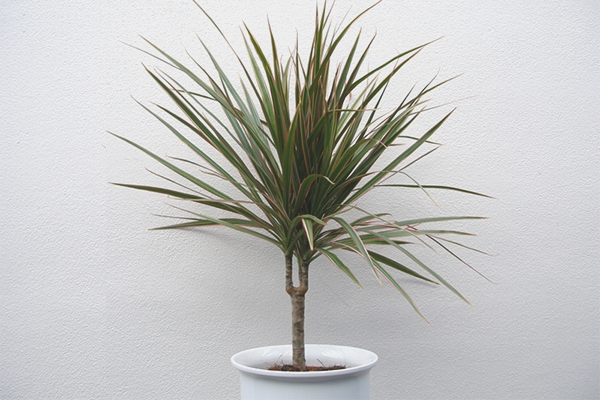
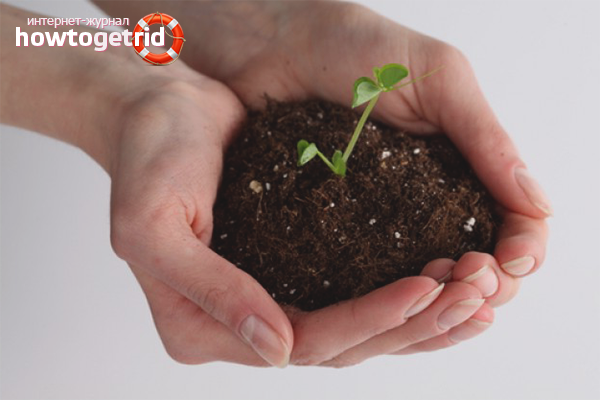

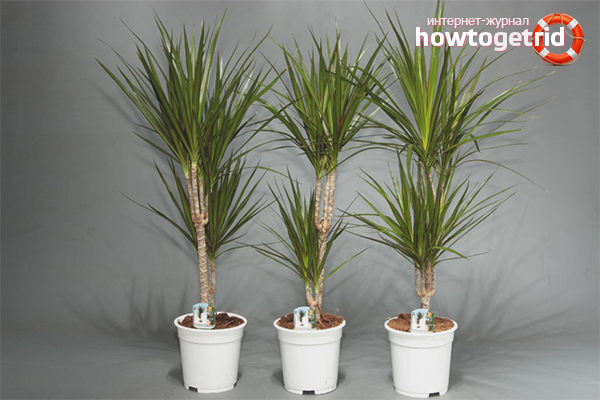




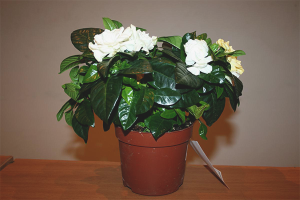
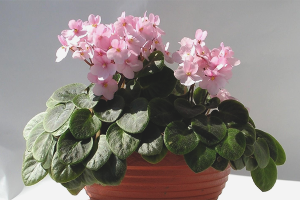



To send